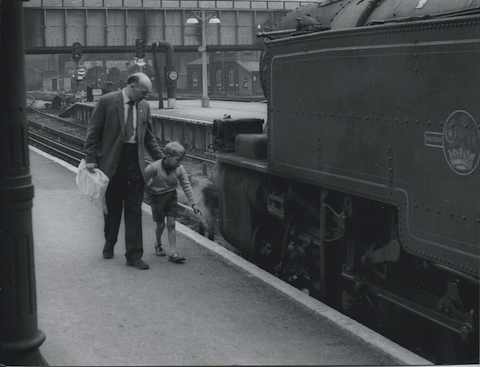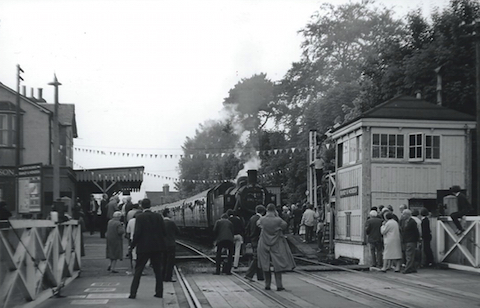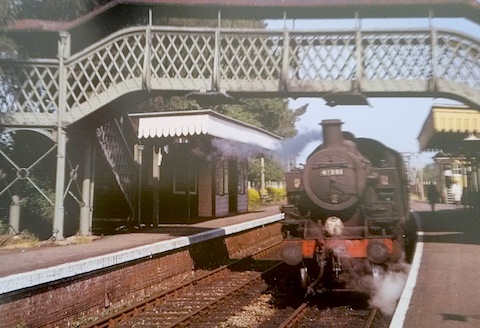 Abraham Lincoln
If given the truth, the people can be depended upon to meet any national crisis...
Abraham Lincoln
If given the truth, the people can be depended upon to meet any national crisis...
 Guildford news...
for Guildford people, brought to you by Guildford reporters - Guildford's own news service
Guildford news...
for Guildford people, brought to you by Guildford reporters - Guildford's own news service
Opinion: What The Doctor Ordered Made The Railways Better
Published on: 12 Jun, 2015
Updated on: 12 Jun, 2015
By David Rose
I was at Guildford railway station 50 years ago when the last trains ran over the Guildford to Horsham branch line.
Just five years old at the time, my dad took me there to see the steam engines. I can’t remember whether it was the Saturday or Sunday, June 12 or 13. But I do remember the following Wednesday’s Surrey Advertiser with pictures of the final train on the Sunday, doubled headed by two steam engines. ‘Coffee Pots’ or ‘Charlies’ as they were known to train buffs.

Me and my dad looking at an engine at Guildford waiting to depart for Horsham, Whitsun 1965. Picture by Roderick Hoyle.
I think that was probably the first time I looked at a newspaper. Perhaps it was that story that sparked what eventually became my interest and career in local newspapers.
Within two years of the closure of the Guildford to Horsham line, steam engines on British Railways’ Southern Region were gone; never to return I was told. I have always been a fan of ‘steam’ and as I was growing up I, perhaps like many others, came to view Dr Richard Beeching, as the enemy of railway enthusiasts. I didn’t grasp the fact that the demise of steam locos was all part of a wider modernisation plan of the UK’s railways.
But back then I guess my views were for nostalgic reasons rather than economic ones. It’s said that the good Dr Beeching told the others bosses at British Railways that they should not try to ‘do everything’.
He urged them to concentrate on what the railways did best – long-distance travel (a service which was later named Intercity), commuter trains and heavy freight. Now, I see that he was right.
Several things have come about in recent decades. For instance, our Intercity train services are widely held as being successful and well run with more and more passengers travelling by rail. Today’s modern trains make commuting more bearable (although I have never been tempted to join those who travel to and from London to work on a daily basis).
Everything is much cleaner today. My earliest memories of train travel, and even in more recent times, are of filthy coaches and dirty seats. Simply opening the door of the now-gone ‘slam door’ trains or opening a window seemed to leave muck and grease on your hands.
And I remember steam train spotting on the platforms of Guildford and Woking stations. You had to be careful if you sat on a station bench, lest it was covered in smut from a steam train!
Also, where would us train enthusiasts be without our wonderful heritage railways? I believe it must have been the hastened withdrawal of steam locos (West Germany, for example, gradually withdrew theirs) that made those really dedicated steam fans work so hard, most as volunteers, to reopen closed lines as ‘preserved railways’ and save so many of our wonderful steams engines from the scrap heap and lovingly restore them to their former glory.
Our heritage railways and those who make them run are a fantastic asset to our leisure services. And that includes the many ‘Santa specials’ and Thomas the Tank Engine days that bring in a whole lot of extra visitors on top of the die-hard steam buffs.

One of the tank engines that ran over the Guildford to Horsham branch pictured from Yorkie’s Bridge, Guildford, in 1964. This is how David Rose remembers steam locos. Picture: Robert Hind collection.
Ever a realist, I do find our heritage railways a bit too clean for my liking! Nostalgia taking over here again. My far away memories of steam trains are of grimy engines and all that dirt. Can we have a little of that please to make my experience when I get a chance to visit the Bluebell Railway or the Mid Hants that bit more real? Probably not, as it might damage overall visitor numbers, and anyway, I expect ‘health and safety’ would rule it out.
Some mistakes were, in hindsight, made when the Beeching axe fell. Perhaps some lines should not have been closed and the tracks ripped up and the land sold off. In France, for example, certain lines there were ‘mothballed’ in case the need arose to open them again.
It could be argued that the line from Guildford to Horsham should have been saved or ‘put at rest’. It’s said the track was ripped up in weeks of it closure.

Believed to be Locomotive Club of Great Britain special at Bramley and Wonersh on June 6, 1965. Picture: Richard Halton collection. Can anyone confirm or not?
Several times over the last couple of decades there have been calls and speculative schemes to get the line re-opened. It now forms the popular Downs Link footpath.
Suggestions have included a clean light electric railway that could be laid over the existing trackbed with the footpath running beside it. So far, none of these schemes have come to anything.
A year ago, the Surrey and Sussex Railway Society, formed by young railway enthusiasts Richard Harrold and Neil Jackson, proposed that the the route from Guildford to Cranleigh should be opened as a heritage line. It argued that reopening the route as others had suggested as a light rail service would be a complete waste of time and money.
In March 2015 it was reported that a petition had been signed by 2,000 people calling for the line to be reopened. Rumours are that a private company has also been looking into the idea.
Opponents have expressed fears that a new railway over the Downs Link would lead to more development.
Will such a scheme ever see the light of day? What do you think? Let you views be known by leaving a reply in the box below.
Responses to Opinion: What The Doctor Ordered Made The Railways Better
Leave a Comment Cancel replyPlease see our comments policy. All comments are moderated and may take time to appear.
Recent Articles
- Guildford Institute’s Crowdfunding Project for Accessible Toilet in its New Community and Wellbeing Centre
- Letter: Guildford – Another Opportunity Missed?
- Letter: GBC’s Corporate Strategy – Where Is the Ambition?
- My Memories of John Mayall at a Ground-breaking Gig in Guildford Nearly Six Decades Ago
- Westborough HMO Plans ‘Losing the Heart of the Street’ Says Resident
- College Invests to Boost Surrey’s Economy and Close Digital Skills Gap
- Community Lottery Brings Big Wins for Local Charities
- GBC Housing Plan Promises ‘A Vibrant Urban Neighbourhood’ Near Town Centre
- Hospital Pillows ‘Shortage’ at the Royal Surrey
- Updated: Caravans Set Up Camp at Ash Manor School


Recent Comments
- Ian Macpherson on Updated: Main Guildford to Godalming Road Closed Until August 1
- Sara Tokunaga on GBC Housing Plan Promises ‘A Vibrant Urban Neighbourhood’ Near Town Centre
- Michael Courtnage on Daily Mail Online Reports Guildford Has Highest-paid Council Officer
- Alan Judge on GBC Housing Plan Promises ‘A Vibrant Urban Neighbourhood’ Near Town Centre
- John Perkins on GBC Housing Plan Promises ‘A Vibrant Urban Neighbourhood’ Near Town Centre
- S Collins on GBC Housing Plan Promises ‘A Vibrant Urban Neighbourhood’ Near Town Centre
Search in Site
Media Gallery
Dragon Interview: Local Artist Leaves Her Mark At One of England’s Most Historic Buildings
January 21, 2023 / No Comment / Read MoreDragon Interview: Lib Dem Planning Chair: ‘Current Policy Doesn’t Work for Local People’
January 19, 2023 / No Comment / Read MoreA3 Tunnel in Guildford ‘Necessary’ for New Homes, Says Guildford’s MP
January 10, 2023 / No Comment / Read More‘Madness’ for London Road Scheme to Go Ahead Against ‘Huge Opposition’, Says SCC Leader
January 6, 2023 / No Comment / Read MoreCouncillor’s Son Starts Campaign for More Consultation on North Street Plan
December 30, 2022 / No Comment / Read MoreCounty Council Climbs Down Over London Road Works – Further ‘Engagement’ Period Announced
December 14, 2022 / No Comment / Read MoreDragon Interview: GBC Reaction to the Government’s Expected Decision to Relax Housing Targets
December 7, 2022 / No Comment / Read MoreHow Can Our Town Centre Businesses Recover? Watch the Shop Front Debate
May 18, 2020 / No Comment / Read More











Mike Melbourne
June 12, 2015 at 9:42 am
Thanks for the tributes and coverage including information from my friend Robert Hills on the other page.
I was there at Bramley and Wonersh station and also at Peasmarsh Junction to see those final runs on what was my favourite branch line.
At least we can still appreciate steam engine ‘Clan Line’ later today running close by at Shalford Junction.
Jim Allen
June 12, 2015 at 2:55 pm
It is interesting to note that about 15 years ago an alleged ‘survey’ of potential requirements of a railway line to Cranleigh took place and it was decided that it was not wanted.
I was living on ‘The Common’ at Cranleigh right near where the old station was situated.
At the time not one person I spoke to knew the survey was being conducted… let alone contributed.
I am not sure who conducted the survey then, or who proposes it now, but as part of a transport link without destroying the very fabric of the area by encouraging more vehicles to use the crowded roads it is an excellent idea.
Ben Darnton
June 25, 2015 at 12:31 am
As a former Cranleigh resident I have seen the huge increase in the amount of road traffic on the A281 and surrounding roads as Cranleigh’s population has steadily increased over the last few years.
I feel the re-instatement of the line from Cranleigh to Guildford would be a good decision as congestion and pollution would be cut and Cranleigh commuters would be able to reach London in an hour, as they could back in the 1965.